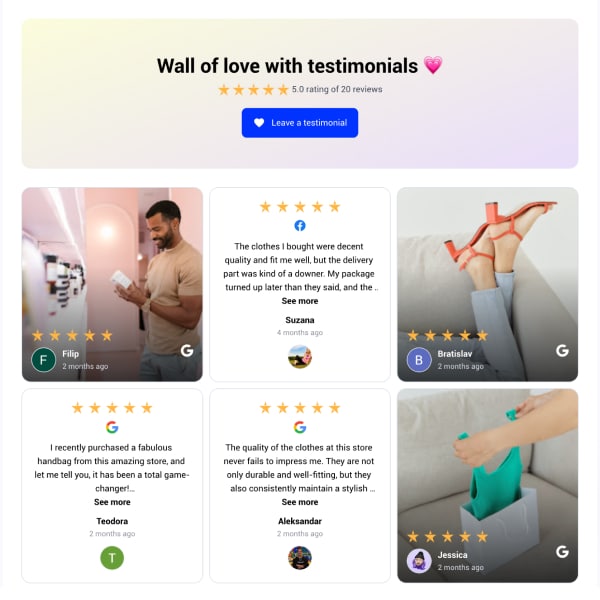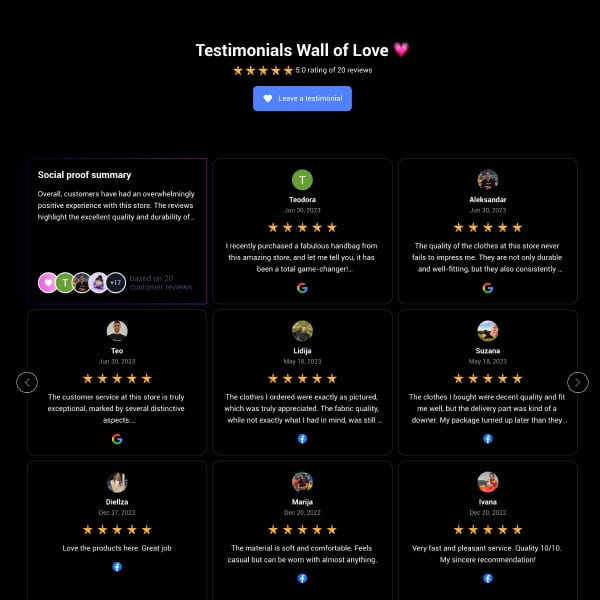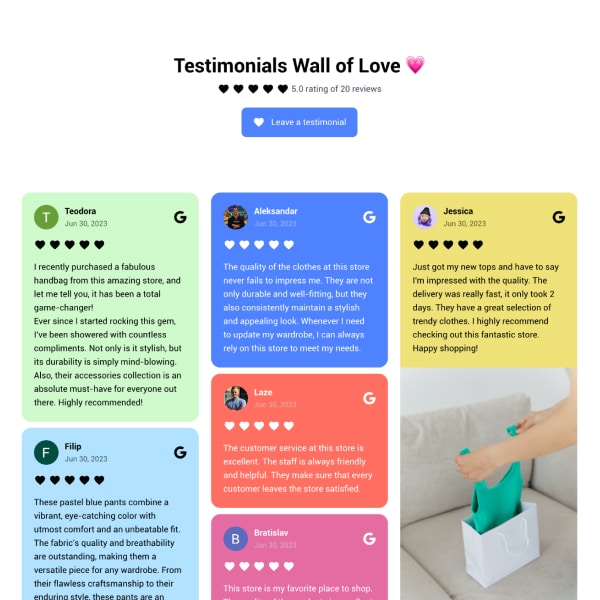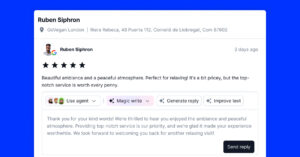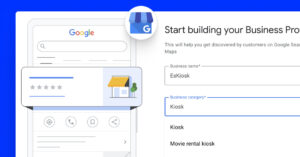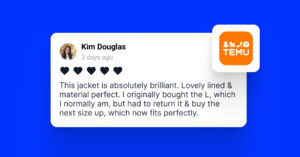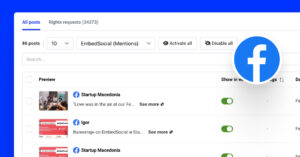When choosing the right testimonial page examples for your business, you want to make sure that you select those relevant to your industry and target audience.
You also want to ensure that the pages are well-designed and easy to navigate. You can find great examples of testimonial pages in a few different places.
In order to make it easier for you, we assembled testimonials page examples and testimonial sections for websites that actually work and can provide social proof to drive more sales.
What is a testimonial?
A testimonial is basically a shoutout from someone who’s used what you’re selling and loved it. It could be from a customer who’s happy with their purchase, a colleague who thinks you’re awesome to work with, or a friend in the business who’s seen your stuff in action. They’re just telling their story about how your product or service made things better for them, kind of like a personal recommendation to others that says, “Hey, these guys are good!”
Testoimonial meaning
It serves as a form of social proof, demonstrating the value and quality of a product or service to potential customers.
Testimonials can come in various formats, including text, video, and social media posts, and they are often featured prominently on a company’s website or marketing materials.
What types of testimonials are there?
In the ever-evolving digital landscape of 2023, testimonials have transformed into a dynamic and multifaceted tool for businesses. They’re no longer just a simple quote on a website; they’ve morphed into a variety of formats, each with its unique charm and effectiveness.
Let’s take a look at the different types of testimonials you can leverage in today’s world:
Google reviews testimonails
Google reviews as testimonials on websites of small businesses are becoming more and more effective due to the proof of their origin. They are authentic, specific and usually very honest as people who write Google reviews are genuinely expressing their experience in order to publicly help other potential customers who consider use the products or services of the company they review.
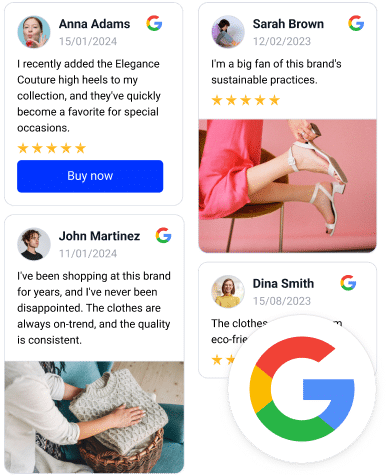
Embed a PRO Google Reviews Widget
Automatically collect and embed Google reviews and use AI reviews management tools to unlock your website’s sales potential.
FYI: You can automatically embed Google reviews widget on your website and show authentic user-generated reviews, increasing trust for more sales. Try it now.
Audio testimonials
Welcome to the era of podcasts and voice assistants, where audio testimonials are making waves. They’re personal, intimate, and easy to consume on the go. It’s like having a satisfied customer whispering their praise into the ears of your potential clients.
Video customer testimonials
In the age of TikTok and YouTube, video testimonials are the shining stars. They’re engaging, dynamic, and incredibly persuasive. It’s like watching a mini-documentary about a customer’s positive experience with your brand.
Case study testimonials
Case studies and customer success stories are the deep dive of the comprehensive analyses. They detail a customer’s journey, from the problem they faced to how your product or service provided the solution. It’s like a detective story, with your brand playing the hero.
Quote testimonials
The classics never go out of style. Quote testimonials are straightforward, honest, and to the point. It’s like a mini endorsement, a stamp of approval from a satisfied customer.
Press review testimonials
Blog post testimonials
A positive review can go a long way in the blogosphere. Blog post testimonials are detailed and personal and often reach a niche audience. It’s like having a friendly chat about your brand over a cup of coffee.
Peer review testimonials
Authority testimonials
Customer interviews testimonials
Social media testimonials and recommendations
So, there you have it, the diverse universe of testimonials in 2023. Each type is unique, powerful, and ready to boost your brand’s reputation.
Why should you use customer testimonials?
Adding testimonials is a powerful tool in your marketing arsenal, and for good reason. They offer a multitude of practical benefits that can significantly enhance your business’s reputation, credibility, and, ultimately its bottom line. Here’s why you should be using customer testimonials:
- Establish Trust: Testimonials from satisfied customers can make your business seem more trustworthy. For instance, a testimonial praising your prompt customer service can assure potential customers of your responsiveness.
- Increase Conversion Rates: Positive testimonials can convince potential customers to try your product or service, leading to higher conversion rates. For example, a testimonial stating how your software improved productivity could persuade potential customers to purchase.
- Showcase Product Features: Testimonials can highlight specific product features. A customer describing how your fitness program’s mobile app is easy to use can draw attention to your app’s user-friendly design.
- Demonstrate Usage: Testimonials can show how your product or service is used in real-life scenarios. A testimonial from a customer explaining how they used your DIY kit to build a backyard shed provides a practical example of your product in action.
- Encourage Engagement: Testimonials can prompt potential customers to interact with your brand, such as visiting your website testimonials or leaving their own.
- Boost SEO: Regularly updated testimonials can improve your website’s search engine ranking. For instance, a series of testimonials using keywords related to your product can make your website more likely to appear in relevant search results.
How to write a testimonial?
Ask customers to:
- Be realistic and genuine.
- Be specific
- Be clear and concise
- Be honest
- Provide your information
As a business owner, you understand the power of customer testimonials in building trust and boosting sales. But how can you guide your customers to write effective testimonials? Here’s a step-by-step guide:
- Encourage sharing realistic and personal experiences: Ask your customers to share their personal experiences with your product or service. Encourage them to be specific about how they used it and the problem it solved for them.
- Prompt for specific benefits: Request your customers to highlight the specific benefits they received. Did your product save them time or help them achieve a goal? Concrete examples make testimonials more relatable and convincing.
- Advocate for clarity: While details are important, a concise and focused testimonial can often be more impactful. Encourage your customers to keep their testimonials concise and to the point.
- Promote honesty and authenticity: Authenticity is key in testimonials. Encourage your customers to share their genuine thoughts and feelings. If there was something they loved about your product or service, they should feel free to express it!
- Suggest including name and a photo (Optional): A testimonial with a name and photo can seem more credible. However, respect your customer’s decision if they prefer to remain anonymous.
For instance, you might guide your customer to write something like this:
“As a user of [Your Company’s Product] for six months, I’ve saved hours of work each week and doubled my monthly sales. I’m thrilled with the results. – [Customer’s Name]”
Suggest a testimonial example
Remember, your customers’ time and effort in writing a testimonial are valuable. Their feedback not only helps you improve but also assists other customers in making informed decisions. Always express your gratitude for their support!
Customer testimonial page examples
1. Showcase use cases like Dropbox
Dropbox’s website is a good example of a software company that focuses on displaying the use cases of its product so other prospective customers can make a choice.
Their page is called Customer Stories, and here, they have added many different types of media, including videos, case studies, and customer quotes.
Their message is also quite clear: Learn how businesses do more with Dropbox. You immediately get the sense that this might be the page where you’ll find the stories of businesses like yours and find if somebody is using Dropbox that has the same use-case as yours.
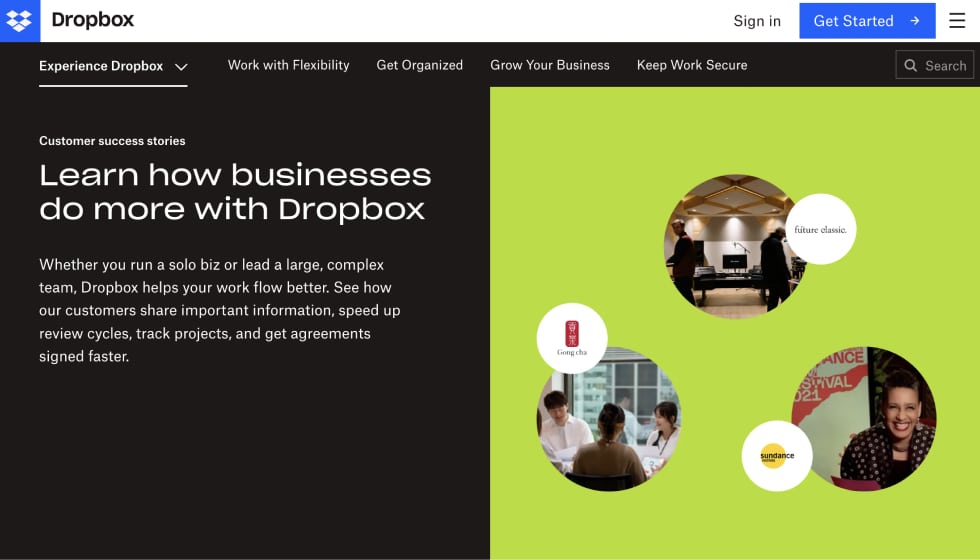
2. Emphasize verified reviews from real buyers like Upright
Once you land on the Upright website, you will similarly notice the word verified’ and emphasize the number of reviews, which is a lot – 15,000. The word Verified is all over the place, and it actually means that these reviews are from buyers, real customers who are relevant (not fake testimonials) and submitted the review from a system that can verify that they actually bought the product.
Their page is again all about these verified reviews, and its design showcases different types of widgets that capture different customer feedback formats, such as a reviews slider widget, a video testimonials section, and a simple and full reviews table widget that shows all the reviews generated from the reviews management software that they use.
Upright has one of the best testimonial examples for a website, and here is a sneak peek of their reviews page:
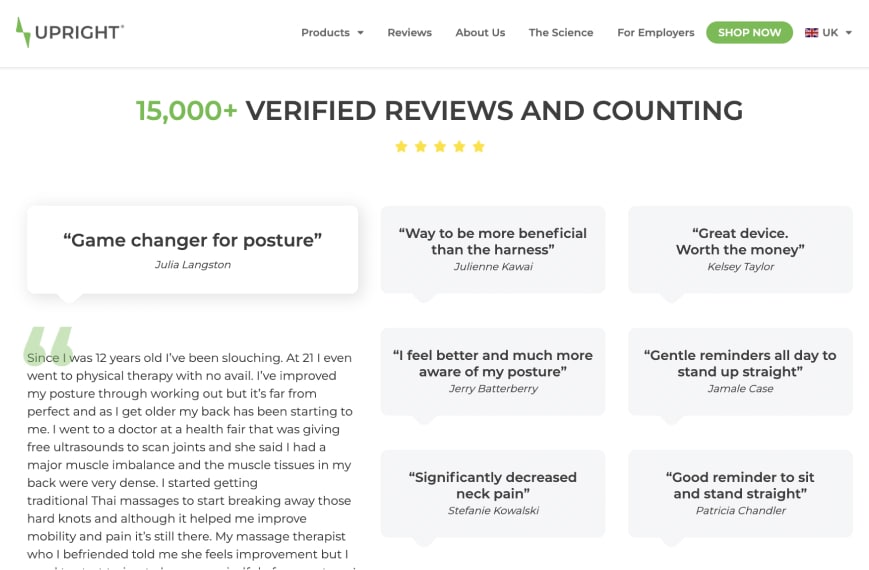
3. Use reviews to answer customer dilemmas like Warby Parker
Warby Parker’s testimonials page notes what you can expect. It is very different from other standard review pages and is structured in a non-conventional showcase of the reviews – they are categorized by specific important topics that the customers are mostly questioning.
They have topics such as:
- Quality
- Home Try-On
- Pricing
- Customer service
- Retail stores B
- Buy a Pair, Give a Pair
- Business
When clicked for each of them, there is an actual answer from the company with a parallel section with the reviews to go with the official text that also includes a call-to-action for the customer to continue their journey after their dilemma was answered.
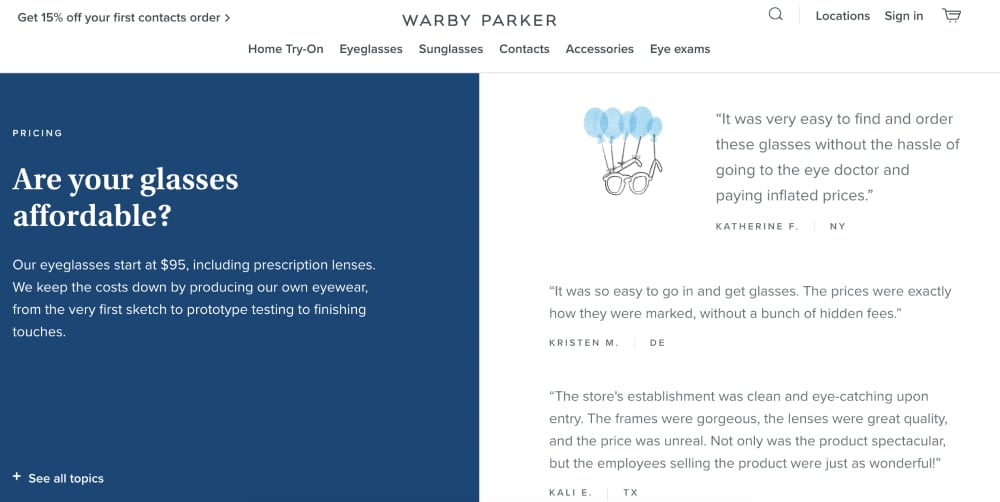
4. Show the brand using your product like Zendesk
Zendesk has a large base of positive customer testimonials, making it into our best website testimonial examples. They’ve worked with some of the greatest brands out there and know how to brag about it.
Their testimonials page is pretty simple, showing a set of cards named after Zendesk’s client. The goal is to make it easier for visitors to find a business similar to theirs and provide social proof that most big companies already use their products. Here’s what it looks like:
5. Display Video Testimonials like TopTal
Toptal is an online network of tech freelancers who can be hired on a project basis and is one of the best testimonial examples for websites.
Their testimonial page is pretty simple, called Clients, where they display customer testimonials mostly from enterprise clients, and the video format they use makes them show effective testimonials.
Here you can find many stories about their client’s projects. Most importantly, they highlight how their clients executed successful projects with the help of Toptal’s freelancers. All their testimonials are backed with client quotes from real people and video stories. From this page, people can navigate to a separate page and read more details about the testimonial. Plus, they emphasize the company logos so enterprise clients can immidiatly see that other big brands use their platform.
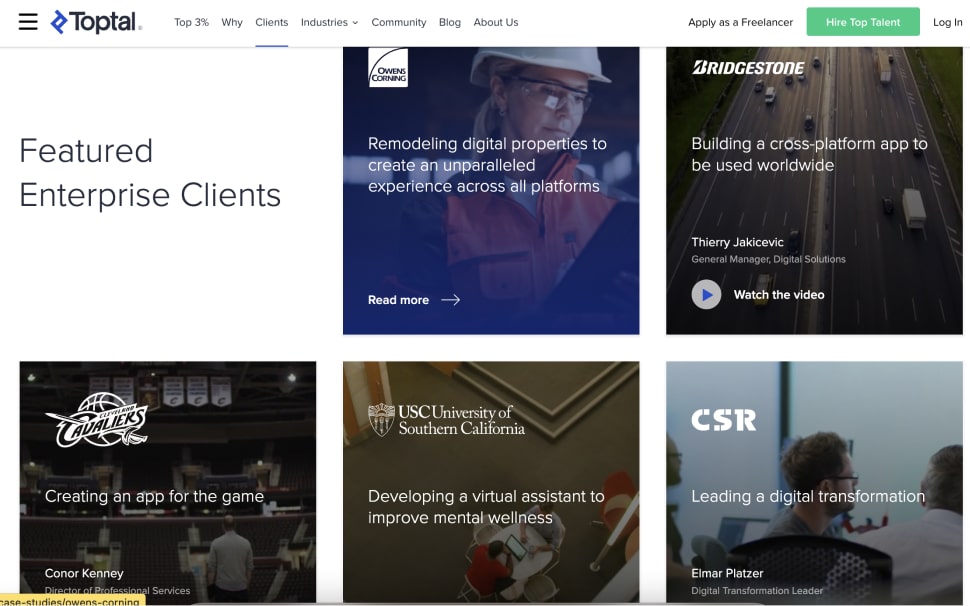
6. Share the community love like Dribble
Dribble’s testimonial page is slightly different from the ones we have listed. After all, it’s a website for designers, and it must be creative and stand out.
Their dedicated testimonial page is made of quotes from designers who use Dribble. The quotes describe why they started using Dribble and how their lives changed after that. They are also enriched with appealing images and video testimonials, with a link to the designer’s Dribble profile, adding extra transparency and trust to the testimonial.
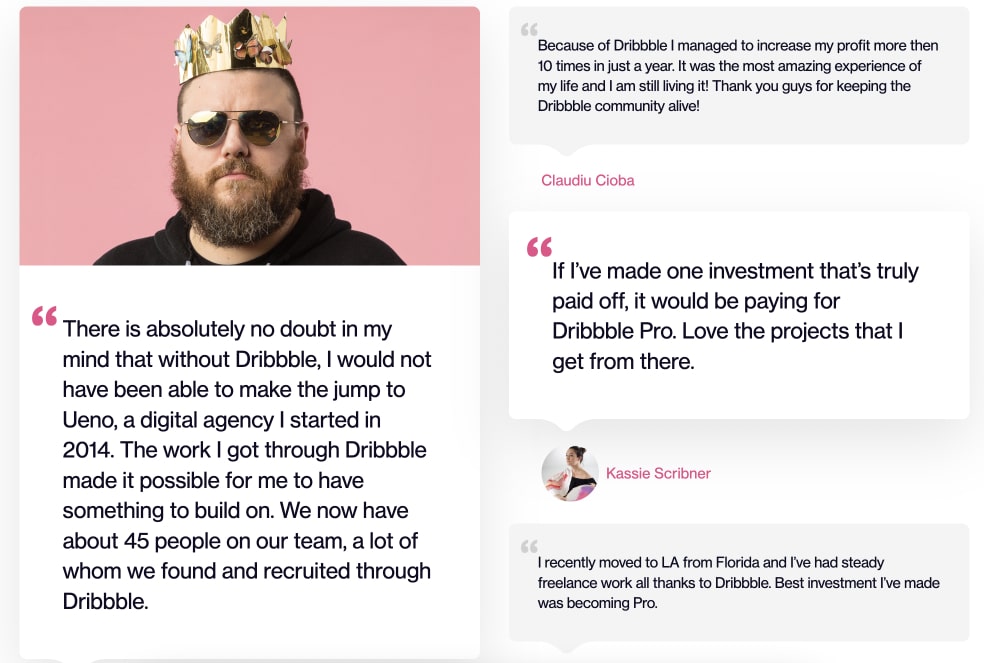
7. Share customers’ success stories like Xaro
The testimonials page by Xero is really easy to use and nicely designed. It includes thorough biographies of its clients, which truly helps you feel a connection to their experiences.
The fact that it focuses on real people who use Xero is what makes this testimonial page special.
For example, one of the stories is about John, who shares a family business with his sister. John is a very easy person to relate to for everyone working in their family business.
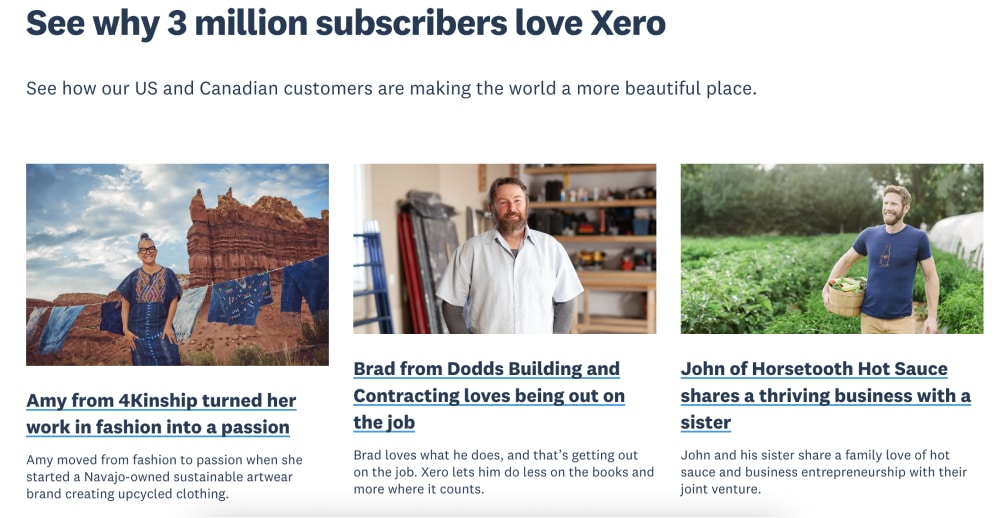
8. Show before and after like Basecamp
This is probably the most creative testimonial page you’ve ever seen. Basecamp’s testimonial page is called Before and After.
It’s divided into two parts. In the first part, they’ve added customer quotes about how they worked before implementing Basecamp in their work setup.
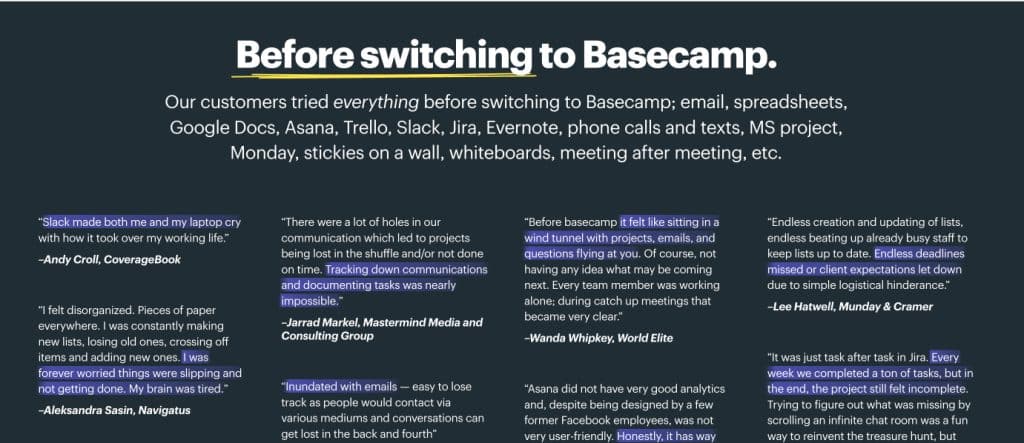
In the second part, customers’ testimonials speak about how Basecamp made their lives easier. The testimonial design is simple and genius at the same time!
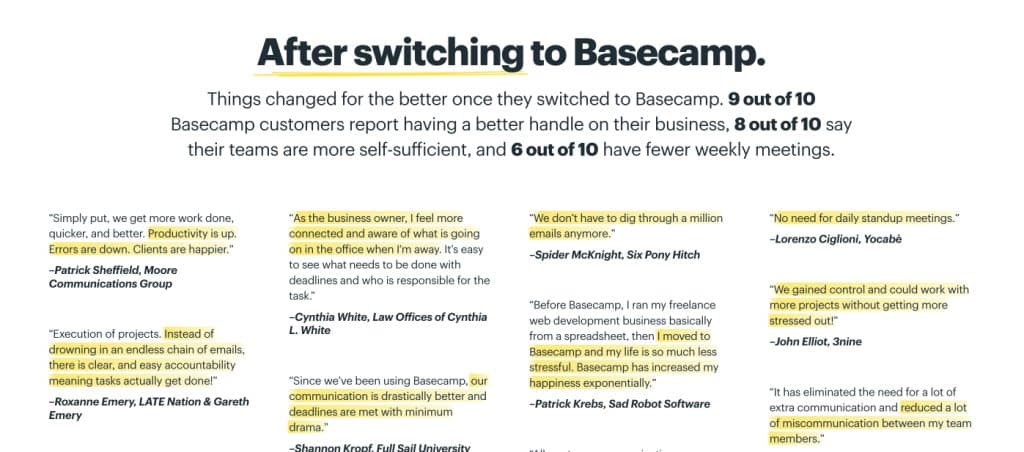
They also have a full Basecamp customers page where they list tons of satisfied customers.
When it comes to showcasing customer experience with their platform, they represent them in a very creative way.
Testimonials as features text – Basecamp is using its customer testimonials to describe its software features. This is just a great idea. When you use your customer words to explain the benefits of the features you provide, it makes a very good copyrighting material that closely resonates with your target audience.
Cool ‘Testimonials’ logo labels feature testimonials next to the logo. And when you click, you can list through what satisfied customers talk about Basecamp.
Highlighters for the best quotes – this actually is handy for reading online reviews. They have highlighted the best words and sentences that their customer wrote and are making the reviews page more interesting and quick to read.
Check out BaseCamp’s Testimonials Page.
9. Categorize success stories by industry like Hubspot
HubSpot has one of the greatest testimonial pages, using case studies as a testimonial format. As they are selling enterprise software at a higher price, they need to create resources that will thoroughly explain to customers how to implement the software and what they get from it.
Their case studies are categorized by industry. This is a brilliant idea because potential customers can find their own industry and identify a similar use case to theirs.
Other things to note are that they strongly emphasize the user’s value, show the benefit in an again categorized format, and also show exactly which product/feature is explained in the customer story.
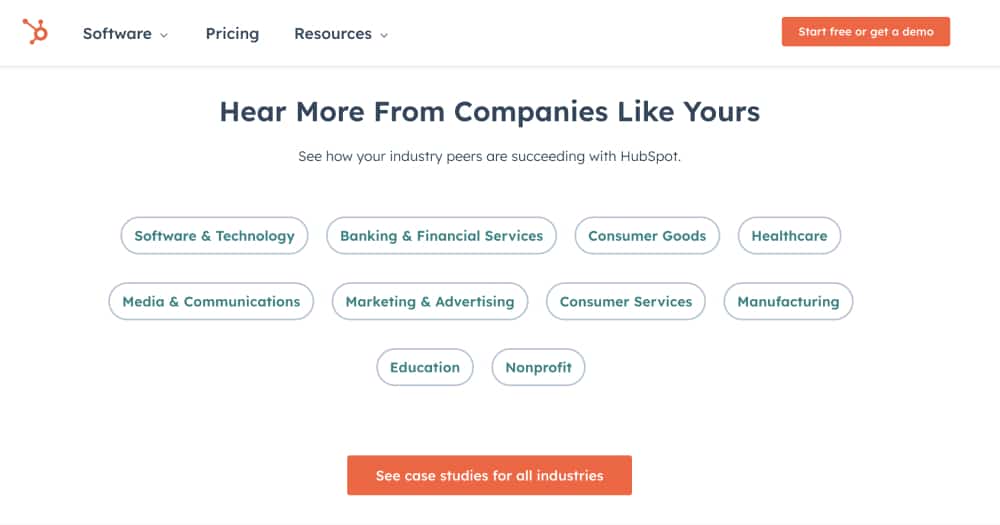
10. Mix customer stories, reviews, and video testimonials like Lumen
Lumen is a very successful D2C brand that started with an Indigogo campaign and spread worldwide among millions of users. They are developing a cutting-edge health product that, based on sophisticated science, helps people regulate their metabolism.
As a complex and technological product, they face a barrier in explaining how it works and its benefits. That is why previous users’ experiences help a lot in this case, so the company has focused on providing this with a rich testimonials page that mixes all: text testimonials, testimonial videos, and expert success stories.
The expert stories come from renowned scientists who have tried the product and experienced its benefits first-hand. They are placed in a way that makes them look like endorsements, giving the whole page more credibility. The reviews are short and sweet, with a call-to-action button redirecting users to try Lumen.
Here is a sneak peek of their great testimonials page:
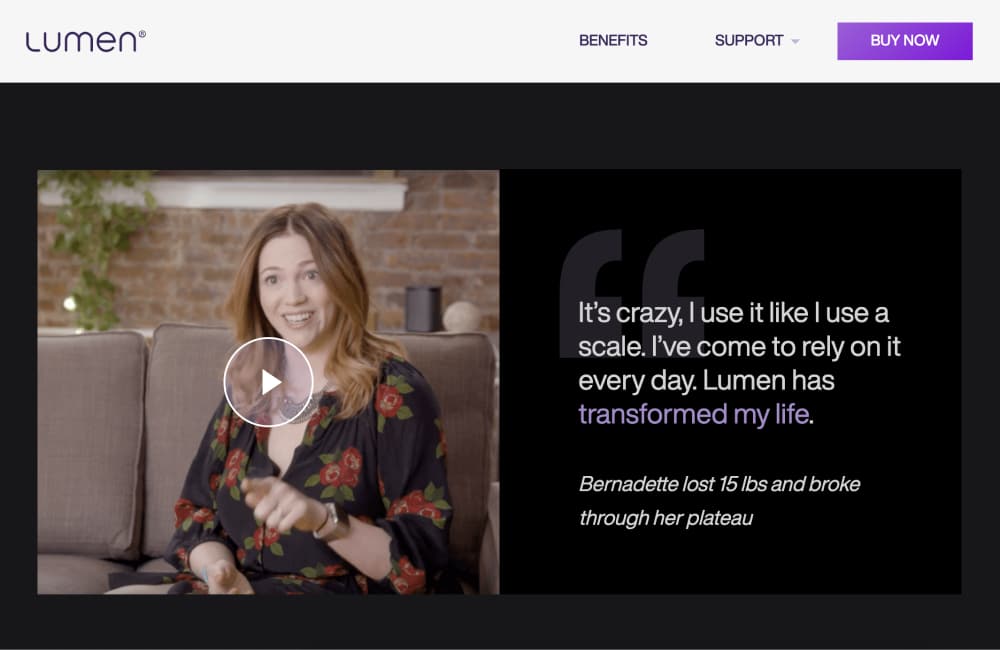
11. Share expert reviews like Athletic Greens
Athletic Green’s Testimonials page includes 3 types of reviews from health experts, professional athletes, and real customers, giving added trust to help potential buyers make decisions.
What I like about this page:
- The reviews are short and to the point
- They include both men and women as their customers
- You can see a transparent rating based on the number of reviews, which is very high
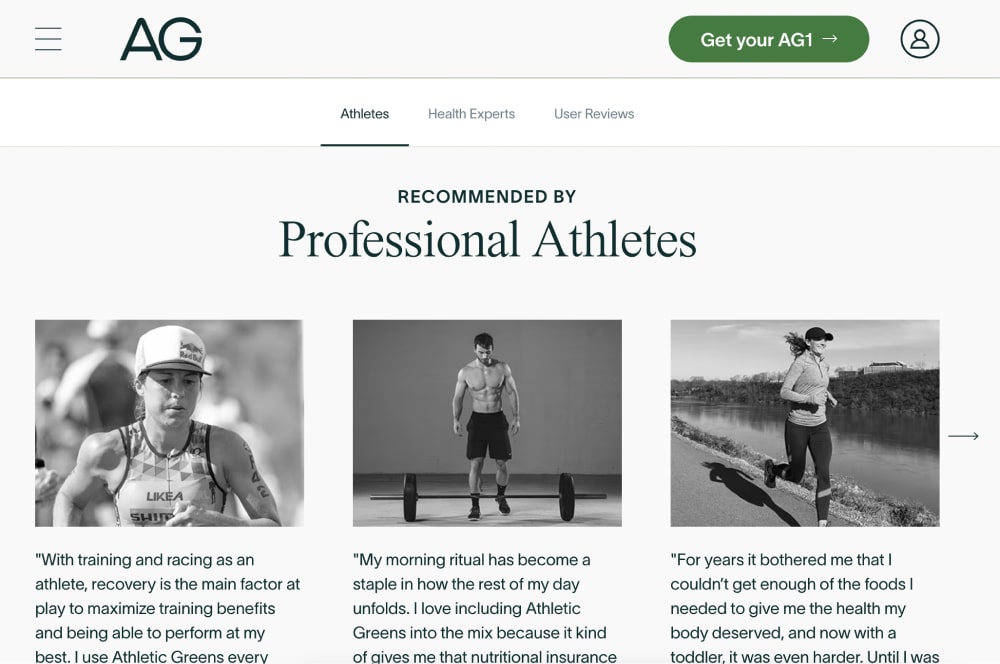
12. Casper Mattress Shows 1-star Reviews
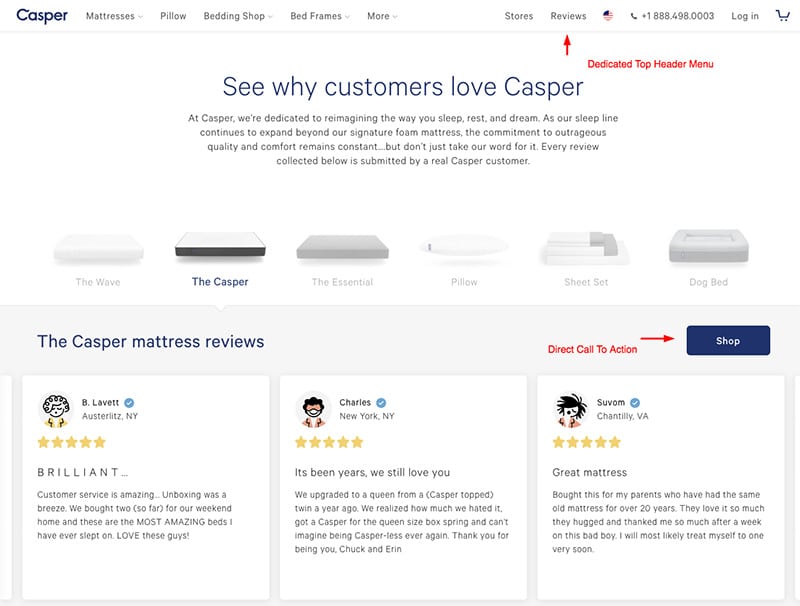
Let’s break down how the famous mattress company Casper is using the customer testimonials page, or the Reviews page, to provide trust for their website visitors.
Dedicated Top Reviews Menu – They have emphasized the importance of the reviews and placed them at the top header navbar to make it visible for visitors to find their customers’ testimonials immediately.
An inline Call To Action button – placing a call to action button in the middle of the reviews page makes total sense, as it shows that this company has probably tested and realized that a big percentage of the potential customers will take action to place an order once they read positive experiences.
Testimonials categories – As you can see, Casper is providing reviews based on a specific category representing their product’s potential benefit. People who value some of the categories most can easily find previous customers’ testimonials.
Showing negative reviews – Additionally, the reviews page has a link that drives people to a dedicated page for ALL reviews that are in the specific category. On this page, the company displays extremely valuable information regarding the reviews, such as the number of reviews and filters by a star rating, so people can also have a chance to read the negative reviews.
I will definitely note that this is one of the rare companies that display so many of their reviews on the website and at the same time also provide 1, 2, or 3-star reviews.
Although the reviews are mostly negative with 1 star, the willingness to show the negative reviews from unsatisfied customers makes the company very legit, gives trustworthiness, and proves that it is impossible to fulfill every customer issue. But always try to make it better.
Last but not least, Casper also provides information on how the review was collected.
Just WOW! Transparency at its best.
As you can see, Jen wrote a great 5-star review, but Casper is saying that This user received a sweepstakes entry for writing a review, a piece of information that might change your perspective when you read her review. Bravo Casper!
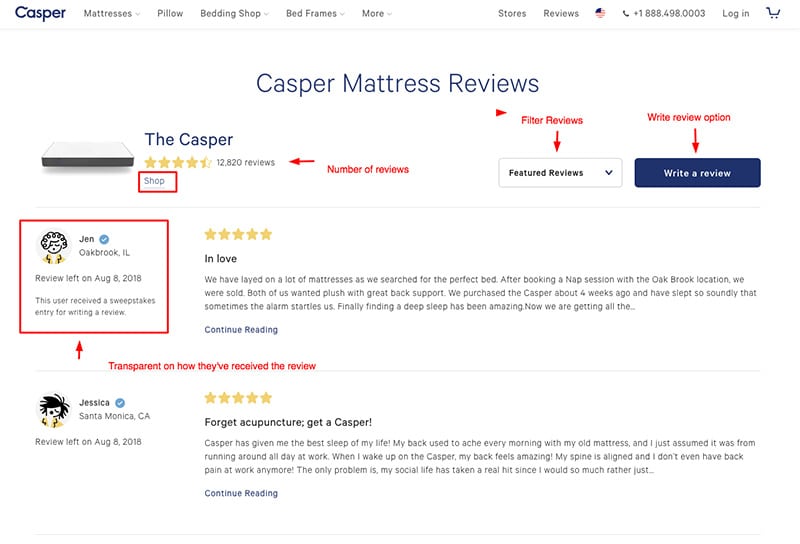
Check out Casper’s Testimonials Page for more inspiration.
13. Highlight the benefits in the reviews like Hey
Hey is an email software that is trying to revolutionize how people receive, read, and send emails.
Similar to the case with Basecamp, Hey is a great example of showing a customer reviews page in a very simple yet powerful design.
The reviews on their home page use a yellow highlight to show potential buyers the product’s benefits and why a customer switched to Hey. Their purpose is obvious. They use a happy customer review to convince users of Gmail, Outlook, or similar email inboxes to switch.
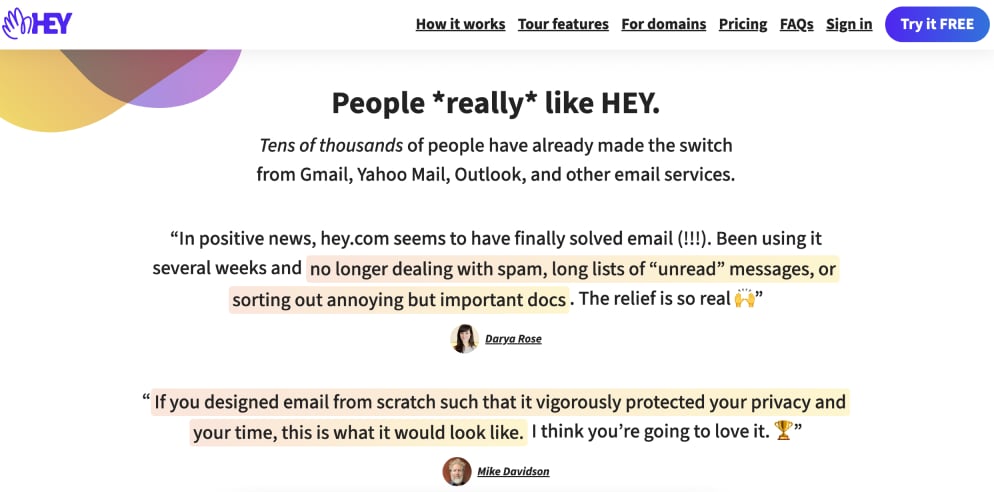
14. FitBit’s Unconventional Reviews Page
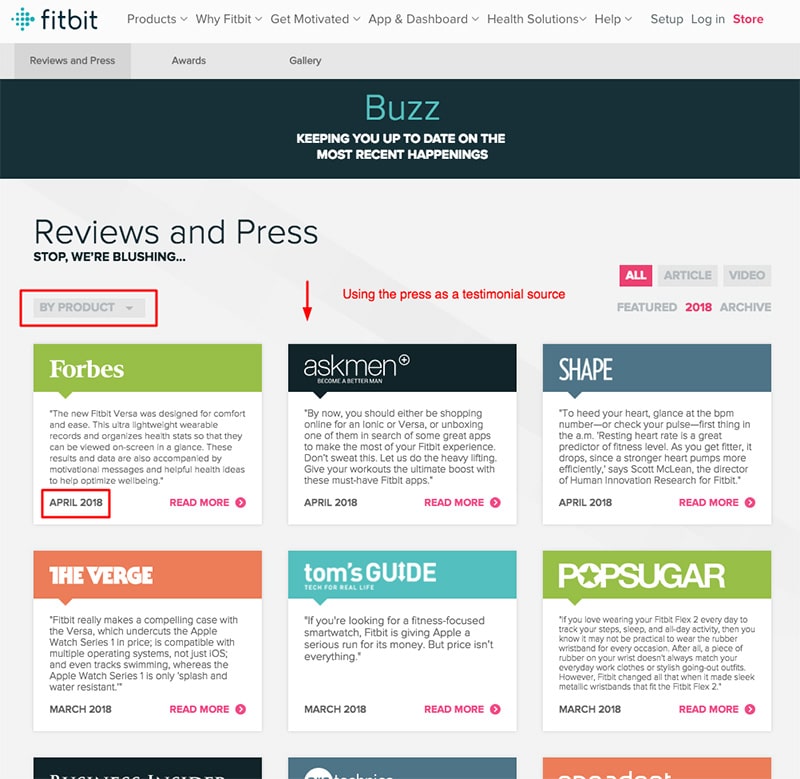
Links to relevant articles – The famous wearable brand has made an interesting approach to showcase reviews about their products from various sources. They are selling tech products, and the most common approach is to provide reviews from tech writers or experienced bloggers who will publicly write about their experience with the product. Please note that most of these publications, such as Engadget, The Verge, and PC Mag, are very familiar to their audience and have a strong reputation in the community. Do not use this approach to pay bloggers to publish your PR-review text; just fake a staged press. This is not how transparency works.
Ambassadors program – This section is very powerful. Fitbit has managed to make products that are just amazing to use and are approved by people with great authority in their fields. The ambassadors’ program features experiences from famous athletes who tell their stories in an interview format with details about why they love the product. For example, here is what Jens Voigt, a former professional cyclist, wrote about FitBit:
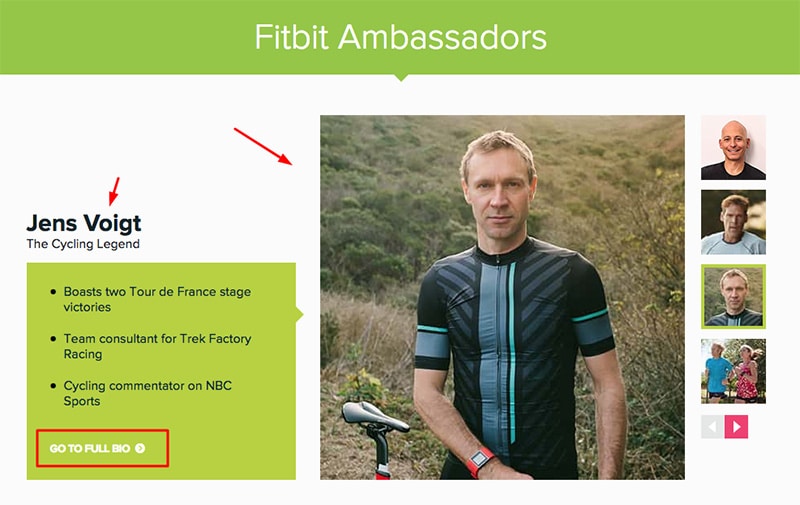
Not staged photos of celebrities wearing Fitbit – When your favorite celebrity uses a product that you are considering purchasing, you will not ever look elsewhere. Especially when this proof appears not planned or in any sense staged or sponsored by the company. Celebrity endorsements are still a thing, but when a celebrity appears who wears a product because they like it, it’s just gold for attracting their followers to want your product. In the example below, you can see that they are showing a spontaneous photo of the famous actress Nina Dobrev with the caption: Nina Dobrev spotted wearing her Fitbit Alta in Santa Monica.

Check out FitBit’s Reviews Page.
15. Ritual Provides Doctor’s Email
Ritual is a company that produces multivitamins for women with the most transparent ingredient list.
We’ve all seen landing pages that promise us a ‘7-day weight loss’, ‘3 steps get younger programs’, or ‘grow hair secret formulas.
To make such a brand legit and stand out in the ‘untrustworthy’ supplement industry, your reviews, claims, and customer experiences must evolve and be REAL.
Ritual is actually trying to do this – provide a unique approach to gain web visitors’ trust. Here are some of the things that they are showcasing:
Direct contact with a doctor is very specific for this type of website and product. You often see expert advice and a video for health products, but these ‘doctor’s approved’ products usually don’t work for some weird reason.
So why Ritual’s doctor page is different?
Well, you can actually reach out to this person and ask for his help. They have the doctor’s email right in the FAQ section, so click on it and send him an email.
But can this approach be improved?
In my opinion, the direct contact with the person is great, but I think that instead of an email such as askluke@ritual.com, they should include a ‘normal person’s email such as luke.bucci@ritual.com that will not seem automated or managed by some intern.
Also, in the era of social media, the company may include direct social media links to the doctor or direct Messenger or Chat room links so a person can talk with the doctor directly.
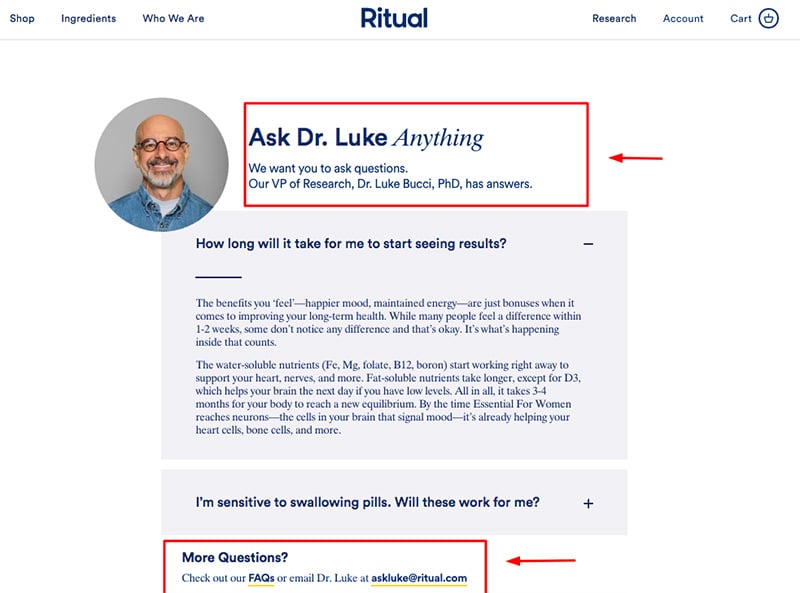
Video testimonials – again, a very common practice for this type of product. The published videos are professionally done, and each of the customers has a relevant occupation, such as a fitness trainer, who gives greater credibility to the website. But, I must say that these videos would be more appealing to the common people if they were pre-generated from Instagram or Facebook profiles and posted publicly by these customers.
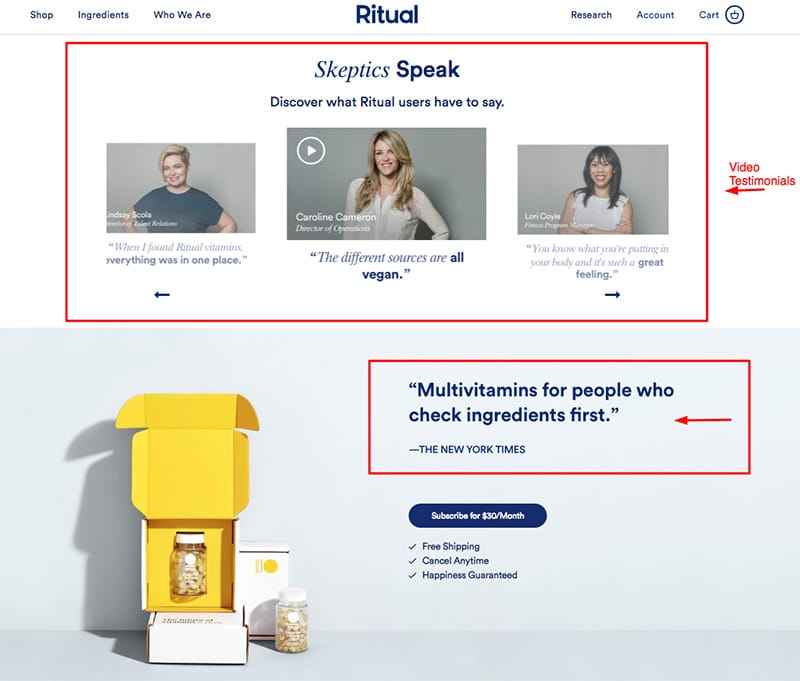
Check out the Ritual Testimonials Page
16. HashChing shows reviews from REAL Facebook users
HashChing is Australia’s first online marketplace for home loans. This is a very specific industry where customer reviews, transparency, and trust are extremely important when it comes to acquiring new customers.
Here are three things that they are doing on their website:
Show relevant business data – Data never lies, and companies that are winning in their markets are always in a great position to provide trust by showing their success metrics. HashChing is doing this by dedicating a core homepage segment to provide transparency and relevancy by emphasizing its success statistics. If you know that a service has 40809 users, it will definitely help you make your decision very fast. And to make this space more interactive, they have also included a video testimonial by one of their users.
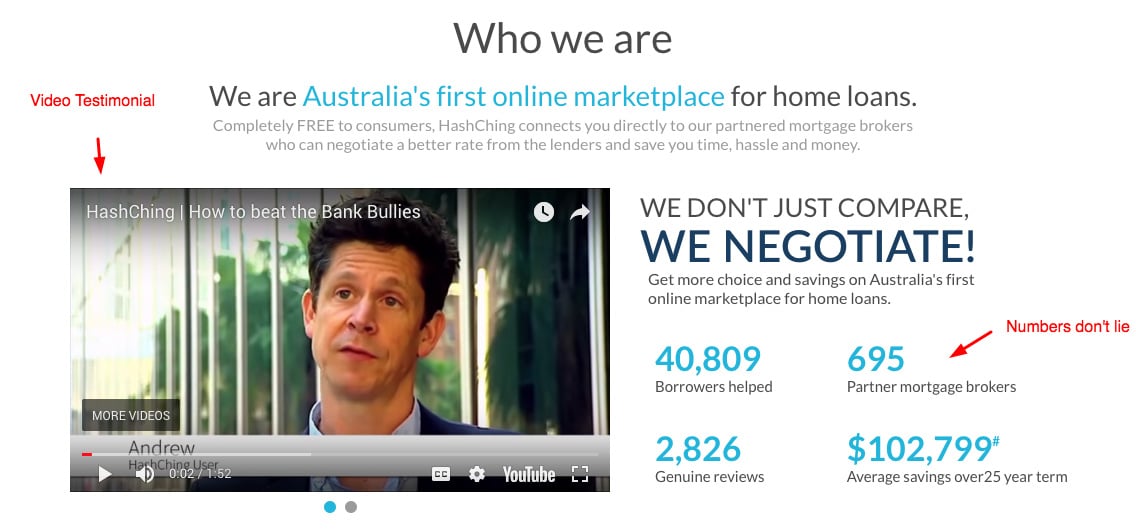
Sync reviews from social media – With the help of EmbedReviews, HashChing syncs in real-time with their Facebook page to generate and display reviews from REAL Facebook users. It is of great importance to show potential customers how you’ve got this review, and with the EmbedReviews functionality, they can easily authenticate that it was pre-generated from an actual person on Facebook who shared the reviews publicly.
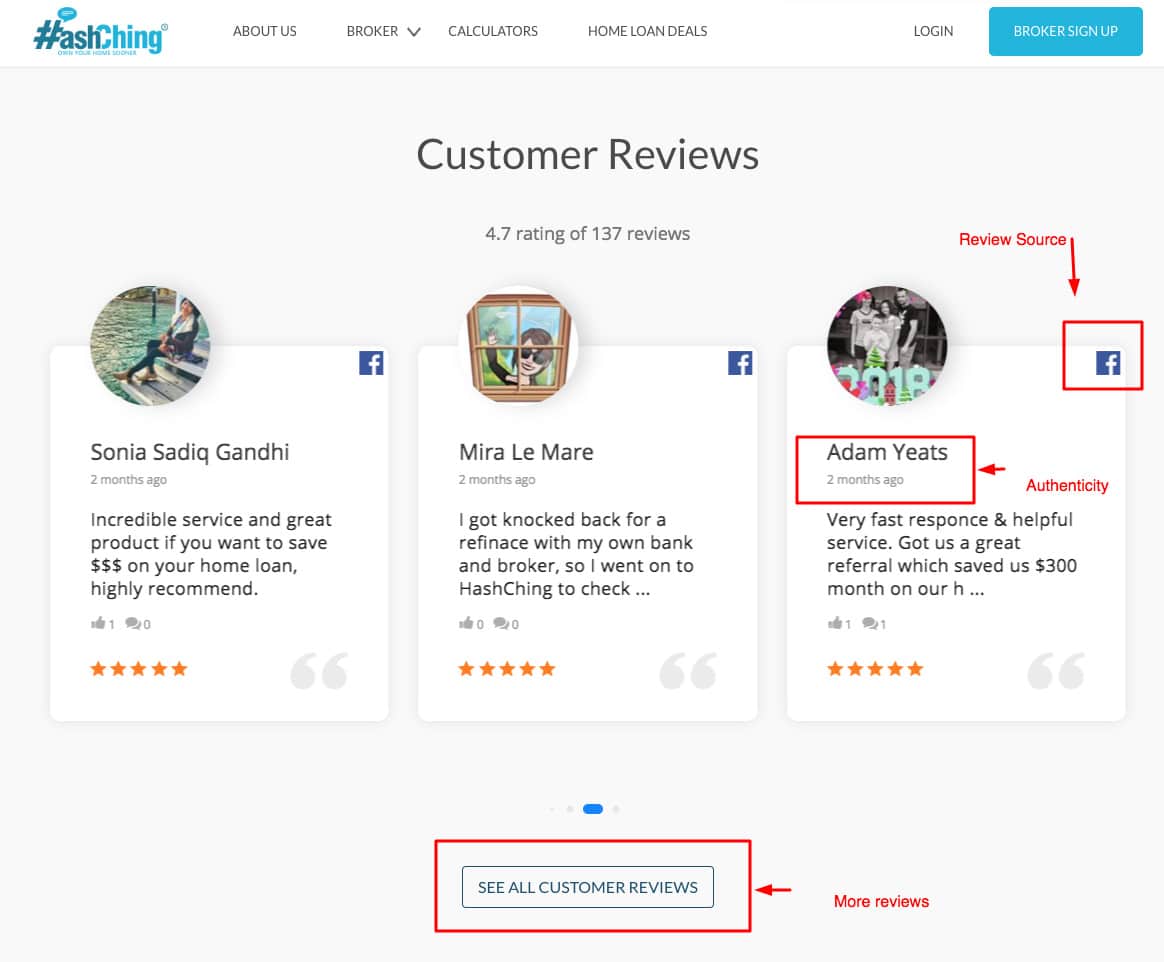
Check out HashChing testimonials page.
17. Shopify Plus
Shopify Plus uses a very smart way of displaying its case study testimonials. The key here is that they point out the previous platforms their current customers used and how Shopify testimonials helped them increase their conversions.
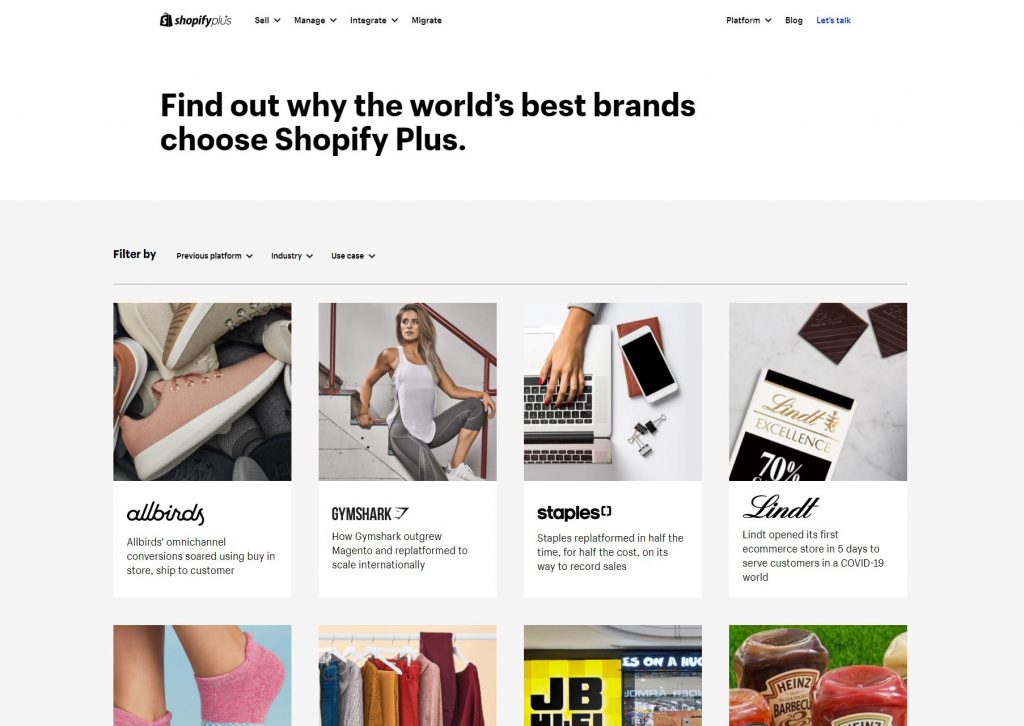
Within the page of a specific customer, they use data, numbers, and three nicely viewable sections:
Challenge – What were the challenges that the customer has faced
Solution – What solution was used (It is almost always Shopify Plus)
Results – the outcome expressed in nice content and timeframe of execution together with a quote
Check out the Shopify Plus testimonials page.
How to create a testimonials page?
Creating a testimonials page is not as difficult as one might think. There are various ways to go about it; the most important thing is to focus on creating an effective and appealing page.
The first step is choosing which customers you would like to feature on your testimonials page. You will want to select happy customers who would be willing to provide a testimonial. Once you have selected the customers you would like to feature, reach out to them and ask if they would be willing to provide a testimonial. If they agree, follow up with them and collect the necessary information, such as their name, title, company, and a quote testimonial.
You can use tools like EmbedReviews to collect customer testimonials from your social media accounts, such as Google reviews.
Here is how to create your own testimonial page with EmbedReviews:
Step 1: Sign up for an account or start a 7-day free trial
Step 2: Choose the testimonials source, like Google or Facebook, or choose to upload your current testimonials.
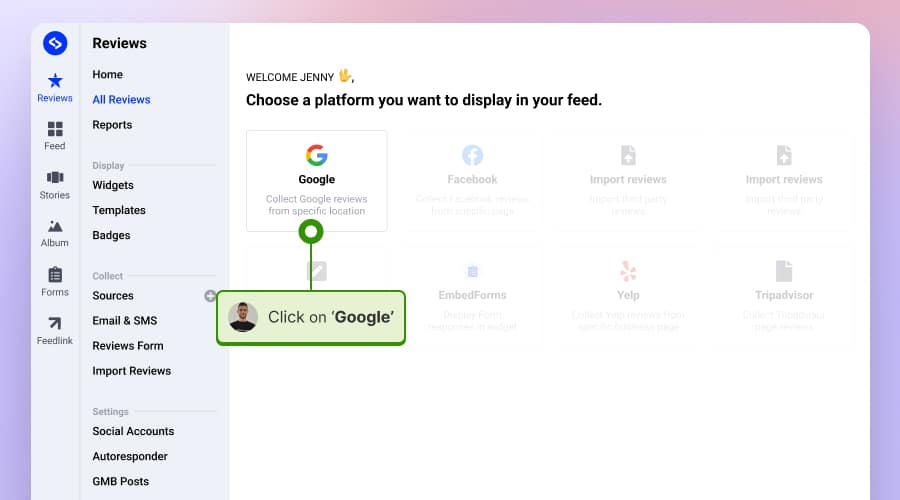
Step 3: Choose the testimonial page you like. You can create from the following templates:
Step 4: in the page editor, go to Embed and copy the provided code
Step 5: Go to your website and create a dedicated testimonials page. Paste the code into the page code.
That’s it. Now, every time you add a new testimonial to the selected source, it will appear on your page.
FYI: You can automatically embed Google reviews widget on your website and show authentic user-generated reviews, increasing trust for more sales. Try it now.
With EmbedReviews, you can pull video testimonials on TikTok or Instagram if you want to take things a step further. Video testimonials in Instagram Reels are a great way to add an extra level of credibility to your testimonials page. To create a video testimonial, you can have your customer record a short video saying something positive about your business. You can then embed the video on your testimonials page.
Testimonial page checklist
Here is a detailed checklist of how you can create a great testimonial page:
- Research your competition and see how they approach their testimonial pages.
- Identify any missed opportunities and make a note of them.
- Create a list of testimonial questions you want to ask your customers in order to get the most impactful testimonials.
- Reach out to your customers and ask them to provide a testimonial. Learn how to ask for testimonials >
- Choose the best testimonials and showcase them prominently on your page.
- Use social proof to add credibility to your testimonials page.
- Test different versions of your testimonials page and see what works best for your business.
- Collect reviews from your social media channels or third-party sites. Learn how to collect more reviews >
If you’re unsure how to get started, look at these testimonial page examples for inspiration.
Testimonial design best practices
Testimonials are a powerful way to build trust and credibility for your brand, product, or service. When designing and displaying testimonials, there are several best practices to keep in mind to ensure they’re effective and resonate with your audience:
Authenticity is key:
- Genuine content: Ensure that all written testimonials you use are authentic and given by real customers. Do not fabricate or exaggerate testimonials, as this can damage your credibility if discovered.
- Photos & Identification: Accompany testimonials with photos and the person giving the testimonial’s full name (if permitted). This adds a layer of authenticity. Include their job title or relation to the product/service if relevant and possible.
- Video Testimonials: Videos can be a potent tool for authenticity. Seeing and hearing real people speak about their experiences can be more persuasive than written text.
Relevance & specificity:
- Targeted Content: Display testimonials that are relevant to the product or service page they’re on. For example, if you have a product for hair growth, use testimonials that specifically address this concern.
- Detail-Oriented: Encourage those giving testimonials to be specific about their experience and the benefits they received. Instead of “The product is great!”, something like “This product helped reduce my hair fall in just three weeks!” is far more compelling.
Easy-to-read design:
- Highlight Key Phrases: Use typography to emphasize certain parts of a particularly powerful testimonial. Bold or italicize key phrases, but use these styles judiciously.
- Consistent Layout: While you may have testimonials of varying lengths, ensure a consistent layout and design for all. This includes consistent fonts, colors, and design elements.
- Include Negative Space: Too much text can be overwhelming. Ensure that there’s enough negative or white space around your testimonials so that they’re easy on the eyes.
Include a mix of testimonials:
- Diverse Range: Aim for a mix of testimonials that cover different aspects of your product or service. This caters to the varied concerns or interests of your potential customers.
- Overcoming Skepticism: If you have testimonials from customers who were initially skeptical but later satisfied with your product/service, include them. They can resonate with potential customers who might have the same reservations.
Remember, the main goal of a testimonial is to build trust. Design your testimonials to reflect the genuine, positive experiences of real people and ensure they’re presented in an easy-to-digest and attractive manner.
What makes a good testimonial page?
As you can see, various ways to showcase testimonials on your website exist. The key is to find what works best for your company, product, or service — and then go for it!
Once you have found a few examples of great testimonial pages, you can begin to design your own Wall of Love page. You will want to ensure that you include all of the elements you saw on the other pages that you liked. This includes featuring the customer as the star, leveraging user-generated content, highlighting company culture, and sharing love with customers. You will also want to ensure that you focus on product features and emphasize the company’s impact. Following these tips, you can create an effective and appealing own testimonial page.
As a summary of these analyzed innovative testimonials pages, here is a list of 10 things you can re-use to enhance trust and transparency and boost conversions on your website.
- Show social media reviews and feedback from REAL people
- Create and show videos with your customers
- Make interviews with famous people in your industry
- Reach out to bloggers or journalists to review your product
- Hire an industry expert to handle customer questions (for delicate products such as health or children)
- Send samples to celebrities that might love your product
- Display the negative reviews, too
- Collect reviews as many as possible from all your web accounts
- Show your business results, the number of users, and similar.
- Use customer quotes to describe features of your product
- Use testimonials in advertising.
Hope this article will help you and your company use more creative approaches to re-alive your website to speak to your prospects sincerely.
Related article:
Wrap up
It’s evident that testimonial pages play a pivotal role in fostering trust and establishing credibility for a brand or service.
They offer prospective clients a window into the experiences of past customers, effectively bridging the trust gap.
If you’re on the lookout for inspiration or benchmarks, our compilation of 20+ testimonial page examples showcases the versatility and effectiveness of well-designed testimonials.
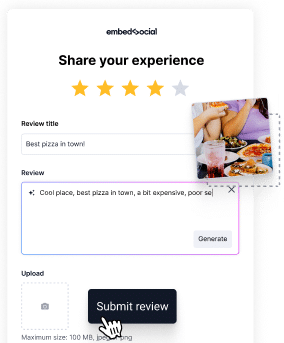
Collect reviews, feedback, and display testimonials widgets at scale!
Use complete reviews management software to generate and display Google reviews widgets on your website.
